Subaru Outback (BR): Road Test with Continuously Variable Transmission
A: INSPECTION
1. GENERAL PRECAUTION
Road tests should be conducted to properly diagnose the condition of CVT.
CAUTION: Always observe the local traffic laws when performing the test.
2. D RANGE SHIFT FUNCTION
Make sure the engine speed is 1,100 - 1,300 rpm while driving on the level road at 50 km/h (31 MPH) after accelerating from halting to 1/4 of accelerator opening angle. Then stop the vehicle. Check normal gear change has occurred while the vehicle speed changes from a constant speed to zero.
3. KICK-DOWN FUNCTION
Check if engine speed will rise by operating the accelerator opening angle to the full from a constant speed of 50 km/h (31 MPH) or more.
4. ENGINE BRAKE OPERATION
- Drive in "6th speed of manual mode" [70 - 80 km/h (43 - 50 MPH) ], and shift down from 6th to 5th. Check if the indicator of combination meter switches "6" → "5". At the same time, check the engine brake in 5th gear.
- Drive in "5th speed of manual mode" [60 - 70 km/h (37 - 43 MPH) ], and shift down from 5th to 4th. Check if the indicator of combination meter switches "5" → "4". At the same time, check the engine brake in 4th gear.
- Drive in "4th speed of manual mode" [50 - 60 km/h (31 - 37 MPH) ], and shift down from 4th to 3rd. Check if the indicator of combination meter switches "4" → "3". At the same time, check the engine brake in 3rd gear.
- Drive in "3rd speed of manual mode" [40 - 50 km/h (25 - 31 MPH) ], and shift down from 3rd to 2nd.
Check if the indicator of combination meter switches "3" → "2". At the same time, check the engine brake in 2nd gear.
- Drive in "2nd speed of manual mode" [20 - 30 km/h (12 - 19 MPH) ], and shift down from 2nd to 1st.
Check if the indicator of combination meter switches "2" → "1". At the same time, check the engine brake in 1st gear.
5. LOCK-UP FUNCTION
When the accelerator is lightly depressed while driving on a flat road in "D" range, check that rpm does not change abruptly.
6. P RANGE OPERATION
Stop the vehicle on an uphill grade of 5% or more and shift to the "P" range and apply the parking brake.
Check that the vehicle does not move when the parking brake is released.
7. NOISE AND VIBRATION
Check for noise and vibration during a constant driving, accelerating, decelerating and manual shift operation.
8. OIL LEAKAGE
After the driving test, inspect for leakage of CVTF and differential gear oil from the transmission body.
Stall Test
A: INSPECTION
CAUTION: Make sure no other person is around the vehicle during stall test measurement.
NOTE: Stall test is extremely important in diagnosing the condition of CVT and engine. The test is necessary to measure the engine stall speeds in "R" and "D" range.
Purposes of the stall test:
- Operational check of forward clutch and reverse brake
- Operational check of the torque converter assembly
- Engine performance check
1) Place wheel chocks at the front and rear of all wheels and engage the electronic parking brake.
2) Turn the A/C OFF.
3) Using the Subaru Select Monitor, check if the throttle valve operates when you depress the accelerator pedal. <Ref. to EN(H4SO)(diag)-33, READ CURRENT DATA FOR ENGINE (NORMAL MODE), OPERATION, Subaru Select Monitor.>
4) Check the engine oil level.
5) Check the coolant level.
6) Adjust the CVTF level. <Ref. to CVT-37, ADJUSTMENT, CVTF.>
7) Increase the CVT temperature to 60 to 80ºC (140 to 176ºF) by idling the engine (with select lever set to "N" or "P" range).
8) Shift the select lever to "D" range.
9) Depress the accelerator pedal to the full while fully depressing the foot brake pedal with your left foot.
10) When the engine speed stabilizes, quickly record the engine speed and release accelerator pedal. Shift the select lever to "N" range. Let the engine idle for one minute or more to cool it down.
11) Shift to "R" range and perform the same stall test.
NOTE:
- Do not perform a stall test for over 5 seconds at a time. (from closed throttle, fully open throttle to stall speed reading.) Failure to follow this instruction will cause the engine oil and CVTF to deteriorate and the clutch and brake to be adversely affected.
- Be sure to cool down the engine for at least one minute after each stall test with the select lever set in the "P" or "N" range and with the idle speed of 1,200 rpm or less.
- If the stall speed is higher than the specified range, attempt to finish the stall test in as short a time as possible, in order to prevent the CVT from sustaining damage.
Stall speed standard: 2,400 - 3,100 rpm
Stall test judgment
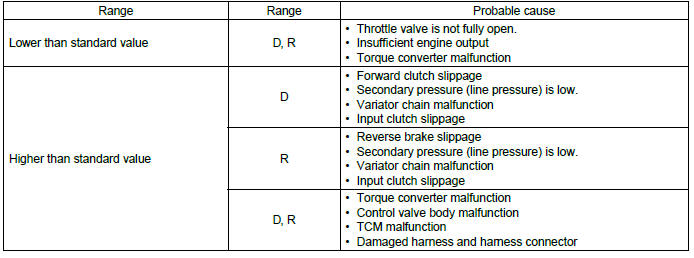
Time Lag Test
A: INSPECTION
NOTE: When the select lever is shifted while the engine is idling, there will be a certain time elapse or lag before shock is felt. This symptom helps to check the condition of forward clutch and reverse brake.
- Perform the test at normal operation CVTF temperature of 60 - 80ºC (140 - 176ºF).
- Be sure to allow one minute or more interval between tests.
- Make three measurements and take the average value.
1) Apply the electronic parking brake.
2) Start the engine. Check the idle speed. (A/C OFF) 3) Shift the select lever from "N" to "D" range. Using a stop watch, measure the time elapsed from shifting the lever until the shock is felt.
Time lag standard: 1.2 seconds or less
If "N" → "D" time lag is longer than specified:
- Secondary pressure (line pressure) is too low.
- Forward clutch worn
- Piston malfunction
- Control valve body malfunction
- Learning incomplete
4) In the same manner, measure the time lag when shifting from "N" range to "R" range.
Time lag standard: 1.5 seconds or less
If "N" → "R" time lag is longer than specified:
- Secondary pressure (line pressure) is too low.
- Reverse brake worn
- Piston malfunction
- Control valve body malfunction
- Learning incomplete
Secondary Pressure (Line Pressure) Test
A: INSPECTION
CAUTION: Make sure no other person is around the vehicle during secondary pressure (line pressure) test measurement.
NOTE:
- If the pulley and variator chain, clutch or brake show signs of slipping or shift feel is not correct, check the secondary pressure (line pressure).
- Connect Subaru Select Monitor to vehicle so as to measure the engine speed and actual secondary pressure (secondary pressure (line pressure) ).
- In many cases, slippage or inability to operate the vehicle may be due to insufficient oil pressure for the operation of clutch, brake or control valve.
1) Remove the front wheel RH. <Ref. to WT-4, REMOVAL, Tire and Wheel.>
2) Lift up the vehicle.
3) Remove the test plug for secondary pressure (line pressure).
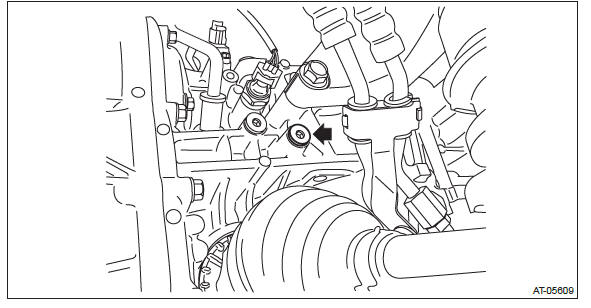
4) Attach ST1, ST2 and ST3 to transmission.
ST1 18801AA000 OIL PRESSURE GAUGE ASSY
ST2 18681AA000 PRESSURE GAUGE ADAPTER
ST3 498897700 OIL PRESSURE ADAPTER SET
NOTE: Used together with genuine O-ring (part No. 806911080) attached to ST2 PRESSURE GAUGE ADAPTER.
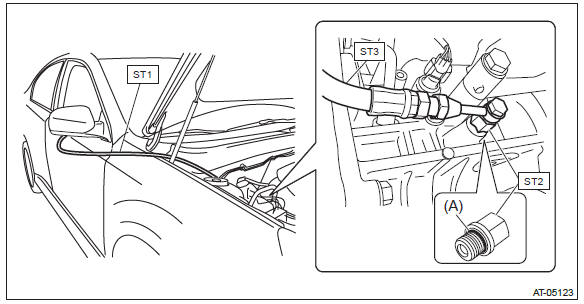
- O-ring (genuine part)
5) Set the gauge so that it can be seen from the driver's seat.
6) Install the front wheel RH. <Ref. to WT-4, INSTALLATION, Tire and Wheel.>
7) Using the Subaru Select Monitor, check if the throttle valve operates when you depress the accelerator pedal. <Ref. to EN(H4SO)(diag)-33, READ CURRENT DATA FOR ENGINE (NORMAL MODE), OPERATION, Subaru Select Monitor.>
8) Check the engine oil level. <Ref. to LU(H4SO)-13, Engine Oil.>
9) Check the coolant level. <Ref. to CO(H4SO)-14, Engine Coolant.>
10) Adjust the CVTF level. <Ref. to CVT-37, ADJUSTMENT, CVTF.>
11) Increase the CVTF temperature to 60 - 80ºC (140 - 176ºF) by idling the engine with the select lever shifted to "N" or "P" range.
12) Shift the select lever to "D" range.
13) Depress the accelerator pedal to the full while fully depressing the foot brake pedal with your left foot.
14) Immediately after the engine speed becomes steady, record the reading of the secondary pressure (line pressure), engine speed and actual secondary pressure on Subaru Select Monitor. And then release the accelerator pedal. Shift the select lever to "N" range. Let the engine idle for one minute or more to cool it down.
NOTE:
- Do not continue the stall test for 5 seconds or more at a time (from fully closed throttle, fully open throttle to secondary pressure (line pressure) reading). Failure to follow this instruction will cause the engine oil and CVTF to deteriorate and the clutch and brake to be adversely affected.
- After performing the secondary pressure (line pressure) test, be sure to cool down the engine for at least one minute with the select lever set in "P" or "N" range and with the idle speed at 1,200 rpm or less.
- Under each condition, check that the measured pressure matches almost totally with actual secondary pressure.
- When both measured pressure and actual secondary pressure are out of specification, judge as control valve malfunction.
- The value at stall is for reference because the pressure changes under different conditions or circumstances.
- The value at idling is steady because it is not affected by any condition or circumstance.

15) Remove the ST and install the plug after measurement.
NOTE: Use new O-rings.
Tightening torque: 25 N*m (2.5 kgf-m, 18.4 ft-lb)
Transfer Clutch Pressure Test
A: INSPECTION
1) Lift up the vehicle.
2) Remove the test plug.
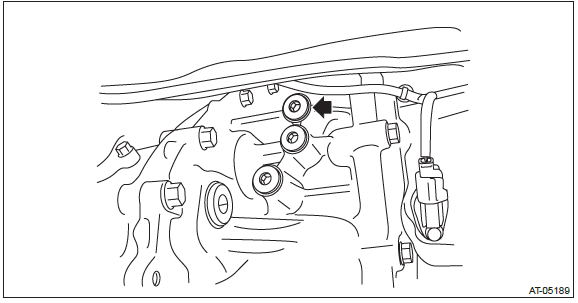
3) Set the ST1, ST2 and ST3 to transmission.
ST1 498575400 OIL PRESSURE GAUGE ASSY
ST2 498897700 OIL PRESSURE ADAPTER SET
ST3 18681AA000 PRESSURE GAUGE ADAPTER
NOTE: Used together with genuine O-ring (part No. 806911080) attached to ST3 PRESSURE GAUGE ADAPTER.
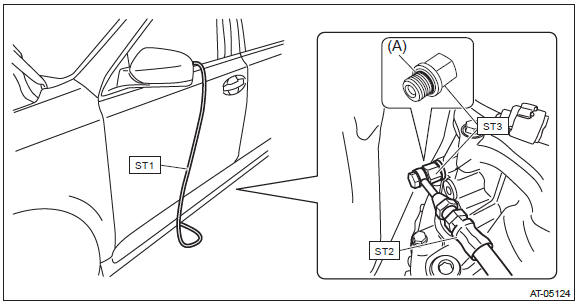
- O-ring (genuine part)
4) Lower the vehicle.
5) Connect the Subaru Select Monitor to the data link connector and read the current data.
6) Check the transfer clutch pressure as in secondary pressure (line pressure) test. <Ref. to CVT-50, Secondary Pressure (Line Pressure) Test.>
NOTE:
- Use Subaru Select Monitor for switching to FWD mode. <Ref. to CVT-45, AWD ON/OFF Switching Mode.>
- If no oil pressure is produced, if it does not change in AWD mode or if oil pressure is produced in FWD mode, there may be a problem in the control valve body.

7) Remove the ST and install the plug after measurement.
NOTE: Use new O-rings.
Tightening torque: 25 N*m (2.5 kgf-m, 18.4 ft-lb)

